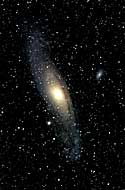
Why a little is better than a lot — usually
When turned on the night sky, a telescope allows you to see millions of things that are otherwise only faintly visible to the naked eye, or not visible at all. The first telescopes seemed like magical devices to those who trained them on the heavens. Today, we don't think of telescopes as magical, but it is nevertheless important to understand how they do what they do.
A telescope renders celestial objects visible by doing two things:
1) using a large lens or mirror to gather far more light than the human eye can alone, thereby making very dim objects visible.
2) magnifying the size of the objects, thereby making the details of them easier to see.
Of those two functions, the first one - gathering more light - is by far the most important. This comes as a surprise to many people, who think that magnification, or power is the linchpin of telescope functionality. The higher the power, the better, one would think. But this isn't so.
High magnification is used primarily for planetary viewing, and then only when the air is very steady. If you ask most visual astronomers how much power they use in their telescopes, you'll find that they prefer low power (under 50x) most of the time, medium power (50x to 150x) some of the time, and high power (over 150x) relatively seldom. Why is this?
The main reason is that many objects in the sky are not really that small. When we see images of beautiful celestial objects — the Orion Nebula, the Andromeda Galaxy, the Lagoon Nebula — we assume them to be tiny, needing a lot of magnification to see. But these objects are not small at all.
Just Because It's Faint Doesn't Mean It's Small
Consider the full Moon. It's a relatively large object, its shape and even considerable detail easily visible to the naked eye. Now consider, say, the Andromeda Galaxy (M31).  It is much dimmer than the Moon and usually requires a telescope to see, so we assume it must be smaller than the Moon. But if you could see them side by size you'd note that the Andromeda Galaxy is really much, much larger than the Moon, and in fact from one end to the other it's almost six times the width of the Moon. The only reason it doesn't dominate the night sky like the Moon does is because it is very dim, not because it's small. This is an object that does not need high magnification, but just the opposite: To see it well requires low magnification, or else you will be able to see only a small piece of it at a time, like looking at a large painting through a straw.
It is much dimmer than the Moon and usually requires a telescope to see, so we assume it must be smaller than the Moon. But if you could see them side by size you'd note that the Andromeda Galaxy is really much, much larger than the Moon, and in fact from one end to the other it's almost six times the width of the Moon. The only reason it doesn't dominate the night sky like the Moon does is because it is very dim, not because it's small. This is an object that does not need high magnification, but just the opposite: To see it well requires low magnification, or else you will be able to see only a small piece of it at a time, like looking at a large painting through a straw.
And so it is with many other celestial objects: The Orion Nebula is a bit larger than the Moon; the Lagoon Nebula is three times the size of the Moon, the North America Nebula is four times the size of the Moon. Even globular clusters, which are often considered small objects, are often one quarter to one half the size of the Moon's disk, objects that would be easily visible to the naked eye if only they were brighter.
It is a telescope's ability to capture light that makes these objects easier to see, not its magnifying power. And a telescope's light-gathering capability is directly related to the size of its primary lens or mirror. The bigger the size, or aperture, of the main optical element, the more light it will collect, and thus the brighter an object will appear.
Calculating Magnification
The magnification is the telescope focal length divided by the eyepiece focal length, in millimeters.
Magnification = Telescope focal length ÷ Eyepiece focal length
For example, if you use a telescope of 1000mm focal length with a 25mm eyepiece, the magnification would be 40x (1000mm ÷ 25 = 40). Doubling the power gives you one-fourth the image brightness and reduces the sharpness by one half.
How Much Power is Enough?
For large objects a low-power (long focal length) eyepiece may be all you want because any higher power will not allow you to see the whole object in the field of view. For smaller objects the general guideline is to use higher power only if it allows you to see more detail. If switching to a higher-power eyepiece results in a loss of visible detail, go back to lower magnification.
The theoretical limit of useful magnification for a telescope is 50 or 60 times the telescope's aperture in inches, or two times the aperture in millimeters. So, for a 60mm refractor, the maximum useful power is 120x (i.e., 120 times the magnification of the naked eye). Higher magnification is pointless, because the image seen in the eyepiece will only be dim and fuzzy.
As a practical matter, it is a rare night when the turbulence in the atmosphere (the "seeing") allows good images at more than 200x to 300x even with larger amateur telescopes, and there are many nights when even 150x is iffy. But 150x is too high a power for many faint deep-sky objects, most of which are more easily seen at magnifications of 50x to 100x. And for the largest deep-sky denizens you'll want the lowest power possible, all the way down to 15x or 20x if your scope can go that low. Those ads for inexpensive telescopes that claim 475x power (or more!) are patently fraudulent! All you would ever see at that power would be a dim, blurry smudge.
 For planets, high power is desirable. Even giant Jupiter is a small disk in the eyepiece, so for planets the lowest useful magnification is 100x or so, and the maximum is whatever the atmosphere and your telescope will allow. Jupiter, Saturn, Mars, and Venus are all bright enough that you can push the power fairly high without the image becoming too dim. But as always, increase magnification only if it reveals more detail; anything more than that is not useful and actually degrades the image.
For planets, high power is desirable. Even giant Jupiter is a small disk in the eyepiece, so for planets the lowest useful magnification is 100x or so, and the maximum is whatever the atmosphere and your telescope will allow. Jupiter, Saturn, Mars, and Venus are all bright enough that you can push the power fairly high without the image becoming too dim. But as always, increase magnification only if it reveals more detail; anything more than that is not useful and actually degrades the image.
Bear in mind, as well, that the goal of astronomy is not just to examine the smallest objects, but also to enjoy the grand sweep of the heavens. Once in a while drop in the low-power eyepiece and just sweep the sky slowly, taking in the sights at random.
The experience can indeed be magical.






 /
/ 







